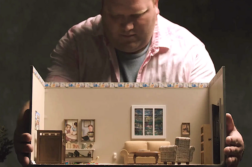Brüno
By/with Sacha Baron Cohen
Directed by Larry Charles
ANYONE going to Brüno expecting a camp film about a very gay fashion journalist—oh, would that have been funny (and it is, for about twelve minutes of the movie)—is going to be sorely disappointed by Sacha Baron Cohen’s latest film. Generally I hold my hands up before my face at movies when they are so violent I can’t bear to watch the blood and gore (the steam bath scene in Eastern Promises, say); this time I held my hands up because the movie was excruciating for other reasons.
Excruciating, appalling, awful: I wasn’t sure what word to apply to the movie during and after the screening. I do know that when I left I couldn’t even find an expression to put on my face as I passed the people outside in the hall waiting to see other movies. I was, I guess, just embarrassed. The odd thing was that Brüno was being shown on three screens in the mall that I went to in Gainesville, Florida—expectations for a Borat-like hit, I assume—but the theater I entered was empty.






